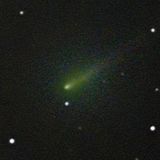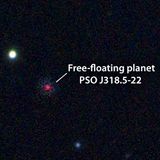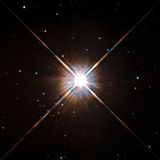
Just when you think NASA's Hubble Space Telescope has discovered everything it possible could, it comes up with something new. In this case, it's a "weird and freakish" object; something we're all aware exists, but it's doing something it shouldn't. Just what oddity have we plucked out of space now? Try an asteroid that has six comet-like dust tails! "We were literally dumbfounded when we saw it," said lead investigator David Jewitt of the University of California at Los Angeles. "Even more amazing, its tail structures change dramatically in just 13 days as it belches out dust. That also caught us by surprise. It's hard to believe we're looking at an asteroid."
When astronomers search for asteroids, they usually find just a small point of light, but this side-show attraction has streaks of material fanning out around it like spokes on a wheel. While some types of asteroids have been known to eject material, this unusual character, designated as P/2013 P5, or just "P5", is displaying behavior that astronomers have never seen: "It's hard to believe we're looking at an asteroid," remarked Jewitt. "We were completely knocked out."
So then, is it a strange asteroid or failed comet? Jewitt further elucidated that P5 has an orbit which could make it a member of the Flora asteroid family. Just what makes Flora-types special? In this case, the odd-ball asteroid could be a fragment of a larger body - a "left-over" from a collision which happened about 200 million years ago. These asteroid pieces are still in similar orbits and are well documented. Meteorites from these fragments show they have been subjected to heating up to as much as 1,500 degrees Fahrenheit. This points to an asteroid comprised of metamorphic rock - a substance not capable of holding volatile ices in the way that comets do.
What could cause this orbiting space rock to have such an incredible formation? Scientists aren't quite sure, but they're willing to hypothesize. P5 was first recovered by the Pan-STARRS survey telescope in Hawaii. The multiple tails were discovered later in Hubble images taken on September 10, 2013. In follow-up observations taken with the Hubble on September 23, the asteroid's appearance had dramatically changed in that short amount of time: the tails had all appeared to have switched sides! This means that either the rotation rate increased to the level where it started flying apart, or something impacted it.
After five months of careful observation, the team was able to dismiss the collision theory. If there were another asteroid that wrecked into P5, the dust would have been released in a single blast. According to modeling done by Jessica Agarwal of the Max Planck Institute for Solar System Research in Lindau, Germany, these "tails" could have been formed by a series of events ranging over a time span that started in mid-April and ended in late August. The "tails" are nothing more than the Sun's radiation pressure acting on the dust and spreading it out in a fan-like formation. "The asteroid could possibly have been spun up if the pressure of sunlight exerted a torque on the body," Jewitt said. "If the asteroid's spin rate became fast enough, the asteroid's weak gravity would no longer be able to hold it together. Dust might avalanche down slope towards the equator, and maybe shatter and fall off, eventually drifting into space to make a tail. So far, only a small fraction of the main mass, perhaps 100 to 1,000 tons of dust, has been lost. The 700-foot-radius nucleus is thousands of times more massive."
What's next on the P5 observing agenda? Astronomers will keep a close watch on how the dust trails react. If they leave the asteroid in the equatorial plane, chances are good that this weird appearance is due to a rotational break-up. In the mean time, researchers will endeavor to calculate the asteroid's true spin rate. It is entirely possible that rotational break-up is a common phenomenon in the asteroid belt; it may even be the main way in which small asteroids die. "In astronomy, where you find one, you eventually find a whole bunch more," Jewitt said. "This is just an amazing object to us, and almost certainly the first of many more to come."
About Tammy Plotner -Tammy is a professional astronomy author, President Emeritus of Warren Rupp Observatory and retired Astronomical League Executive Secretary. She has received a vast number of astronomy achievement and observing awards, including the Great Lakes Astronomy Achievement Award, RG Wright Service Award and the first woman astronomer to achieve Comet Hunter's Gold Status.


















